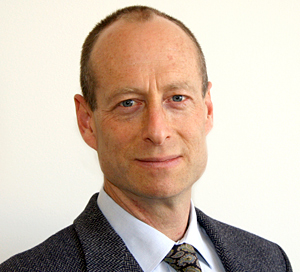From geeky to cool: Statistics is Berkeley’s fastest-growing major
Being a statistician has gone from geeky to cool at UC Berkeley, where statistics has jumped to the top of the list of fastest-growing majors. In just the last four years, the number of majors has increased by 289 percent, and the trend shows no sign of reversing.

April 16, 2013
Any way you count it, the fastest-growing major at UC Berkeley by far is one that long slumbered in obscurity: statistics.
In just the last four years, the number of majors has multiplied from 83 in spring 2009 to 323 this semester. That’s an increase of 240 majors, or 289 percent.
“Being geeky has become a lot cooler than it was years ago,” says statistics professor and department chair Philip Stark. “When I first came to this department as post doc in 1987, it took me years to get over the stigma of being a statistician. But now we’re the cool kids.”

Professor and statistics chair Philip B. Stark.
(Day to day, the number of majors can shift as students add and drop. Timing also comes into play, as rules governing when a major can be declared vary from major to major. In the interest of good statistical methodology, this article will compare like figures: official numbers supplied by campus research analyst Russ Acker from comparable moments in time — spring 2009 and spring 2013.)
According to official counts, computer science in the College of Letters and Science came in second among the fastest-growing large majors. Its numbers more than doubled, from 138 to 357 (up 219 students, or 159 percent) in the last four years.
Cognitive science (in the Department of Undergraduate Interdisciplinary Studies) placed third with a 128 percent rise; and the society and environment major (part of the Department of Environmental Science, Policy and Management in the College of Natural Resources) came in fourth at 99 percent.
Also rising fast were geography (87 percent) and applied mathematics (68 percent). (links to all depts mentioned)
Current trends notwithstanding, none of these majors approach the popularity of UC Berkeley’s top major, electrical engineering and computer science, which has about 1,200 students.
Statistics took off in 2008 at Berkeley, not long before Google chief economist and Berkeley professor emeritus Hal Varian famously said: “I keep saying that the sexy job in the next 10 years will be statisticians. And I’m not kidding.”
“That’s clearly caught on,” says Stark, explaining: Not only has there been an explosion in the amount of data that’s available, but a parallel expansion in computation that allows more to be done with the data.
“There’s an increasing awareness of the power of statistics in all areas — Internet companies, business, marketing, medical research, biotech. So it’s pretty much ubiquitous throughout the culture,” Stark says.
Statistics, data science and machine learning now play a huge role in everything from what ads people see on websites like Facebook, to informing policymakers working on global problems from climate change to the economy. Statisticians could have helped the world avoid the subprime mortgage catastrophe, which occurred in large part because fundamental statistical methods were ignored, says Stark.
“Quant’s at the forefront right now,” he points out, using shorthand for quantitative work, be it in science or on Wall Street. Instead of simply taking a statistics course here and there, he adds, “Majoring in statistics makes you much more employable, if you want to show you really do have quantitative chops.”
His department sees a growing number of double and triple majors, students combining statistics with economics, math, science and computer science.
Yet another factor driving the growth, in Stark’s opinion, is that “a lot of sciences, especially social sciences, are realizing that the neglect or misuse of statistics has held them back or led them astray.” He sees all kinds of statistical fallacies at play in the press and in scientific literature — and his department’s commencement speaker this spring is an expert on the subject, John Ioannidis of Stanford, who says that most medical research is wrong.
At Berkeley, the burst of student interest in statistics has been accompanied by a big push on campus toward expanding the uses of data. This spring saw the launch of D-Lab, the Social Sciences Data Laboratory. Last year, Berkeley landed a $10 million federal grant for the study of Big Data, the terms used for the world’s growing body of digital information of all kinds. The five-year award will fund the campus’s new Algorithms, Machines and People (AMP) Expedition, whose scientists expect to develop new tools to help extract information from big data.
As another indication, the Graduate School of Journalism next month is holding a symposium exploring the intersection of journalism and data.
Extending campus expertise, Stark, along with colleague Ani Adhikari, a senior lecturer at Berkeley, taught an introductory statistics MOOC through edX this spring and some 52,600 students enrolled from all over the world in one five-week module, making it one of the largest edX MOOCs this semester and, Stark says, and the largest BerkeleyX course offered through the Berkeley Resource Center for Online Education (BRCOE) so far. The course also boasted the second-highest completion rate of any MOOC, with 15.5 percent of students completing the course, he adds.
As far as the number of majors goes, Stark says, the department has tightened requirements for declaring the major to help manage the growth. The new requirements take effect after this spring.
“I don’t know how long the growth will continue,” he says, “but I don’t see the trend reversing.”